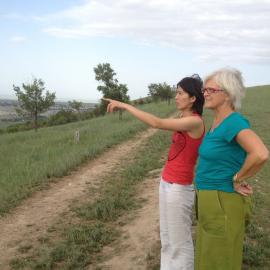My trip to Kyrgyzstan in May and June of 2013 was a tremendous success. The results of the efforts we have made there have really paid off and my friends and colleagues are doing some splendid things. There is much good news about the state of the Kyrgyz cultural property programs that have sprung up in recent years.
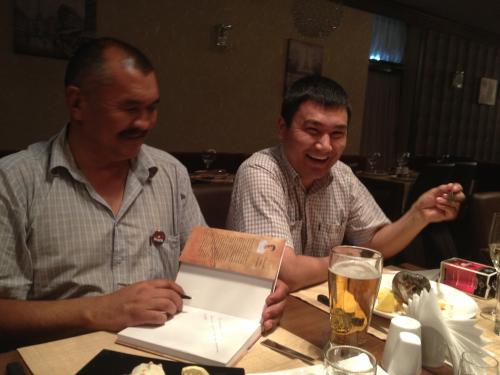
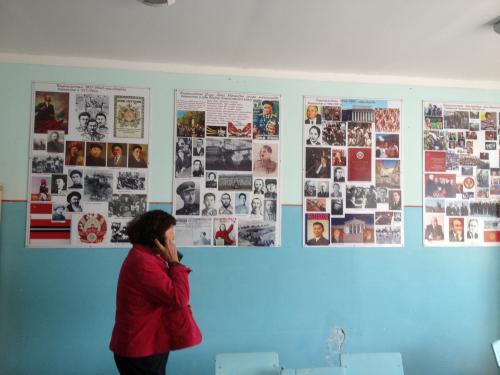
At very top, Aida Abdykanova and Caroline Beebe, overlooking Bishkek; above, Kubat Tabaldiev signs his new book on Kyrgyz archaeology, and Chynarbek Joldoshov celebrates; at left, Asipa Adumbaevaat at Bolot’s school museum at Kara-Suu, with posters made by Kubat Tabaldiev. All photos courtesy of A. Pyburn, used with permission.
Project team member Kubat Tabaldiev, of the National University of Kyrgyzstan, has published the first popular book on Kyrgyz archaeology, with a substantial section on preservation that highlights the programs developed by several project members. Tabaldiev’s book is perfect for Asipa Adumbaeva’s teacher-training workshop, one of the project’s key initiatives, and she has already collected 50 copies for this purpose. Asipa, who is Outreach Coordinator for the Kyrgyz Heritage Association, is making educational materials for schools including maps, puzzles and contests, and I’ll be providing her with educational materials on archaeology as part of this initiative. Another positive development is that the Kyrgyz Sacred Heritage Association has been granted government approval and now has a Facebook page.
On my visit this summer I was given a tour of the community museums developed in school classrooms by two project members. Both museums contain beautiful posters made by Tabaldiev summarizing archaeology and history in the region, as well as small artifact collections that have been brought in by students. The museum in the town of Kara-Suu, housed in Shapak Yrysmendeyer school, has been named for the first teacher at the school, whose photograph hangs on the wall. He was the grandfather of Bolot, the project member who lives in the area and who has created the museum with help from his brother. The second museum, in Kara-Kungoy, located in Ables uulu Alaydar school, was created by project member and school principal Zamir. It has a larger collection of artifacts that have been documented as to provenience and other details of their origins. I was shown the space that Yimadin, another project member, will use for his museum. It is much larger and nicer than I had anticipated, and in the same building as a community auditorium and library. The interior of the museum space has already been painted and plans for the necessary shelves are underway.
“Krasnaya Rechka proves the point that preservation of a monument can never succeed with only outside support, no matter how generous.”
In addition to the museums at Kara Kungoy and Kara-Suu, project members strongly supported the need for a community museum in the village of Kum-Dobo, site of the ancient settlement Kochnar-Bashi, to be developed by Kaiyrbek, who is the current president of the Kyrgyz Sacred Heritage Association. Tabaldiev says that Kaiyrbek “stopped the robbery of Kum-Dobo city, protects culture, and we need to support him.”
I’ve suggested that the radio show that we had planned be realized first as a series of podcasts, beginning with interviews with project members about their efforts. I asked team member Tolkunay to take this on as she has been responsible for some excellent videos and, much to my surprise, she told me she also had previous experience in radio. She thought the podcasts were a great idea.
Aida Abdykanova, a Professor of Archaeology at the American University of Central Asia, briefly considered moving the venue of her tourism workshop (another key initiative of the Kyrgyz project) to Kum-Dobo, but after consideration she said she preferred to continue with the original venue of Tosor. The Anthropology Department at her university is not in good shape, and has very few students. I discussed with Aida the possibility of developing a field program involving American and Kyrgyz students that would take place in about two years, and she was enthusiastic. We’ve created a preliminary field school proposal, a first step in this initiative.
Another team member, Chynarbek Joldoshov, who was Vice-President of the Archaeological Department at the Osh State Museum, has recently moved to Bishkek and has a new job. He is Head Specialist of the Department on Preservation and Development of Historical and Cultural Heritage in the Ministry of Culture, Information and Tourism of Kyrgyz Republic. This is a new office!
Joldoshov discussed site registration, which he is working on for new sites (the last register was made in 1999). Each site now gets a “passport” registration, even if it is on private property. The Minister of Culture makes a list of sites divided into groups: Local, State, International. The list is approved by the Cabinet of Ministry and then sent to the State Register for them to keep track. If it is historical, then it is the property of the government, but this is a problem when it is on private property. These private properties can be sold and the buyer is often not told that it contains a registered archaeological site that belongs to the state. So sometimes the property is sold many times without this knowledge, and this causes an issue when the state wants to step in.
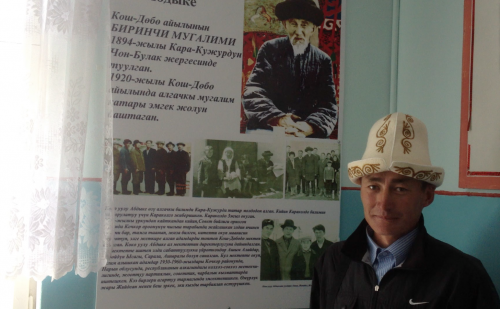
At left, Bolot in the school museum below a poster of his grandfather. Below, project team member and school principal, Zamir, with school flag.
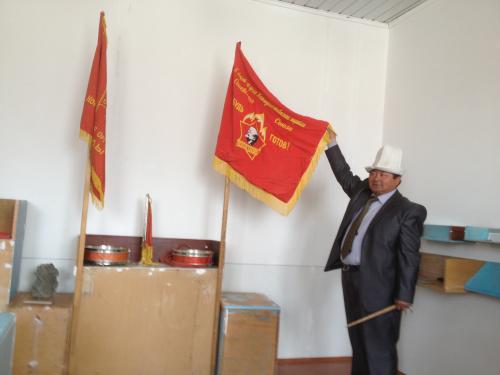
Team member Almaz Jumbekov, a computer specialist in Koch Kor, has been contracted to create the project website. All project materials created with IPinCH support, as well as many that simply relate to the preservation of Kyrgyz cultural property, will be archived on the website. We hope that the project website will eventually be opened to the public.
During my recent visit, Tabaldiev, Abdykanova, and Tolkunay took me to visit Krasnaya Rechka (a.k.a. Navikat), the Buddhist site UNESCO has worked to preserve. It is in sad shape. Millions of dollars were invested in expert consultation and consolidation measures. For a tiny fraction of that amount our grassroots movement has already begun to enlist public interest in preservation, and sites that were being damaged are now being protected. Tabaldiev and Abdykanova vented their frustration about the waste of resources and the preservation strategy that has clearly backfired.
The Krasnaya Rechka site proves the point that preservation of a monument can never succeed with only outside support, no matter how generous. What must happen for preservation to succeed is a transformation that allows people to see local heritage with global eyes. Whether this vision results in preservation or destruction is not predetermined simply by exposing people to an outsider’s view, but to me the important thing is that responsible archaeologists make sure people have the information they need to make informed decisions about their cultural property.
A new Kyrgyz heritage preservation video begins with a traditional Kyrgyz saying that only a slave does not remember his ancestors. This is a powerful sentiment that evokes the Kyrgyz passion for freedom, which is symbolized in the iconography of the Kyrgyz flag. But for me, it also means that the new impetus toward the preservation of heritage and pride in continuity with the past has Indigenous roots. No one is creating community museums in response to pressure from me or as a result of fallout from globalization.
K. Anne Pyburn is a Professor in the
This article was featured in the IPinCH Newsletter Vol. 5 (2013).


